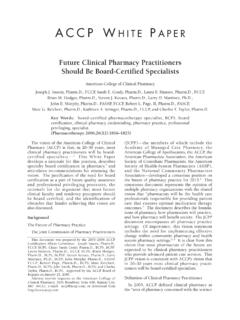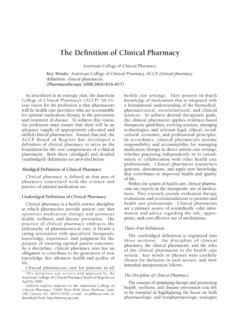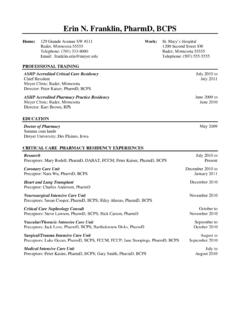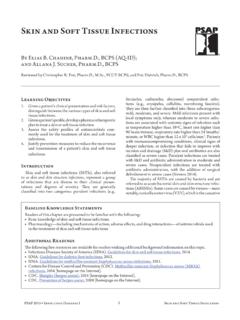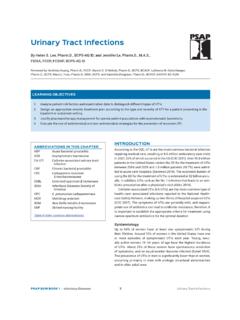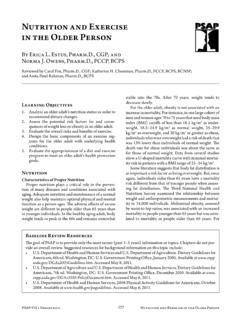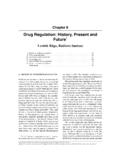Transcription of Adverse Drug Reactions - ACCP
1 PSAP 2015 CNS/Pharmacy Practice5A dverse Drug R eactionsLearning Objectives1. Distinguish Adverse drug Reactions (A DRs) from Adverse drug Devise methods for A DR detection, and classify an A DR when it Discover various worldwide A DR reporting methods and learn how to report A DRs in the United Detect populations most at risk of, and apply pharma-covigilance principles to prevent A Adverse drug reaction (A DR) is an unwanted, unde-sirable effect of a medication that occurs during usual clinical use. Adverse drug Reactions occur almost daily in health care institutions and can adversely affect a patient s quality of life, often causing considerable morbidity and mortality.
2 Much attention has been given to identifying the patient populations most at risk, the drugs most com-monly responsible, and the potential causes of A DRs. An increase in the number of drugs on the market, an aging population, and an upward trend in polypharmacy are contributing factors to the prevalence of A DRs worldwide. Adverse drug Reactions may cause patients to lose confi-dence in or have negative emotions toward their physicians and seek self-treatment options, which may consequently precipitate additional A DRs. Around 5% of all hospital admissions are the result of an A DR, and around 10% 20% of inpatients will have at least one A DR during their hospital stay (Kongkaew 2008; Lundkvist 2004; Pirmohamed 1998).
3 The actual incidence of A DRs may be even greater because some A DRs mimic natural disease states and may thus go undetected and/or unreported. A lthough some A DRs present as minor symptoms, others are serious and cause death in as many as of hospitalized patients (Lazarou 1998; Pirmohamed 1998). Adverse drug Reactions should be quickly identified and managed to limit their detrimental effects on the cost of managing A DRs can be high, whether they occur in the inpatient or the outpatient setting. Because the clinical diagnosis of an A DR is not always obvious, practitioners often order additional laboratory tests or procedures to investigate the cause of a patient s Adverse Drug R eactionsBy Stephanie N.
4 Schatz, Phar , BCPS; and Robert J. Weber, Phar , BCPSR eviewed by Kyle E. Hultgren, ; Erin M. Timpe Behnen, , BCPS; and Michael C. Barros, , BCPS, BCACPB aseline K nowledge Statements Readers of this chapter are presumed to be familiar with the following: Medication errors National Patient Safety Goals Pharmacologic treatment of allergic Reactions General medication precautions and monitoring for high-risk medications Medication reconciliation processA dditiona l R ea dings The following free resources are available for readers wishing additional background information on this topic. Food and Drug Administration (FDA). FDA Adverse Event Reporting System (FA ERS) [homepage on the Internet].
5 American Society of Health-System Pharmacists. ASHP guidelines on Adverse drug reaction monitoring and reporting. Am J Health Syst Pharm 1995;52 2015 CNS/Pharmacy Practice6A dverse Drug R eactionssymptoms. Practitioners may also prescribe pharmaco-therapy for conditions caused by an unrecognized A DR, further increasing costs and the risk of additional A DRs. If the A DR occurs while the patient is hospitalized, length of stay can be prolonged and overall hospitaliza-tion costs may be increased (Gautier 2003; Classen 1997). Additional indirect costs incurred by A DRs include anx-iety or depression and missed days of work for the patient and/or involves the study of drug-related injuries and making warning or withdrawal recommen-dations for pharmaceutical agents; it encompasses the detection, assessment, understanding, and prevention of A DRs.
6 Pharmacists play a vital role in every step of the pharmacovigilance process, which can prevent patients from undergoing unnecessary procedures or taking unwarranted drugs. In addition to preserving the safety and quality of life for the patient, pharmacovigilance can represent a cost savings to the patient and the health care institution. By reporting known or suspected A DRs, phar-macists, other health care practitioners, and patients can assist in identifying patterns and trends, which may lead to increased regulatory scrutiny or even the withdrawal of drugs that do not have a favorable risk-benefit chapter discusses methods of A DR detection and classification and the associated treatment strate-gies.
7 Populations most at risk are identified, together with various worldwide A DR reporting methods. Pharmacovigilance strategies are described to assist practitioners in preventing A DRs, associated hospital admissions, and readmissions in their patient of A DR sDefining A DR sThe definition of an A DR is often confused with that of an Adverse drug event (A DE). The World Health Organization (W HO) defines an A DE as any untoward medical occurrence that may present during treatment with a pharmaceutical product but which does not nec-essarily have a causal relationship with this treatment (W HO 2005).
8 The W HO defines an A DR as a response to a drug which is noxious and unintended and which occurs at doses normally used in man for prophylaxis, diagnosis, or therapy of disease or for the modification of physiologic function. An A DR is a type of A DE whose cause can be directly attributed to a drug and its physiologic properties. A main distinction between A DRs and A DEs is that A DRs occur despite appropriate prescribing and dosing, whereas A DEs may also be associated with inappropriate use of the drug or other confounders that occur during drug therapy but are not necessarily caused by the pharmacology of the drug itself. A causal relationship is suspected for an A DR but is not required for an A DE.
9 Adverse drug events may also be caused by medication errors, which the National Coordinating Council for Medication Error Reporting and Prevention (NCC MER P) defines as any preventable event that may cause or lead to inappropriate medication use or patient harm while the medication is in the con-trol of the health care professional, patient, or consumer. Figure 1-1 shows the relationship between A DRs, A DEs, and medication studies of A DRs, A DEs, and medication errors often use these terms interchangeably, leading to inconsis-tency in the reported prevalence of each. Definitions are often subject to the individual researcher s preference, making the interpretation of results and reproducibility difficult (Lisby 2010).
10 Standardizing and using terminol-ogy such as that defined by the Medical Dictionary for Regulatory Activities can improve the quality and consis-tency of research in this realm. Other publication authors and governing bodies that have proposed alternative Abbreviations in This chapter A DE Adverse drug eventA DR Adverse drug reactionBOOST Better Outcomes for Older Adults Through Safe TransitionsFA ERS FDA Adverse Event Reporting SystemISMP Institute for Safe Medication PracticesNCC MERP National Coordinating Council for Medication Error Reporting and PreventionTJC The Joint CommissionFigure 1-1. Relationship of key terms in medication with permission from Nebeker JR , Barach P, Samore MH.
